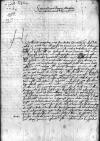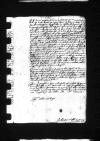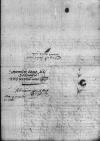Ad ⌊⌋ Maiestatis Vestrae Serenissimae 1530-08-21⌊21(!) Augusti1530-08-21⌋ ex ⌊Cracovia⌋ ad me datas non potui hucusque respondere, cum se certus tabellarius non offerret, si tamen illustrissimus dominus ⌊Georgius, dux Saxoniae⌋, Maiestati Vestrae Serenissimae 1530-08-06⌊6 Augusti praeteriti1530-08-06⌋ non rescripsisset de omnibus, quae affinitatem et concordiam tractandam spectant, unum de ⌊fratribus⌋ meis ad Maiestatem Vestram Serenissimam transmittere decreveram, quo diutius in ambiguo non versaretur. Quandoquidem 1530-09-02⌊eodem die1530-09-02⌋, quo litteras Maiestatis Vestrae Serenissimae accepi, illustrisimum dominum ⌊ducem Georgium⌋ conveni et illi litteras Maiestatis Vestrae Serenissimae reddidi, quas postquam perlegisset, cum eo ad longum de omnibus egi; ille se ad ea 6 Augusti Maiestati Vestrae Serenissimae respondisse asseruit et exemplum litterarum mihi legi iussit cum responso serenissimi ⌊Ferdinandi regis⌋, quod litteris eiusdem ad Maiestatem Vestram Serenissimam inclusum fuisse dicebat. Ego obtuli operam meam iuxta mandatum Maiestatis Vestrae Serenissimae, si illa in his negotiis apud serenissimum ⌊Ferdinandum regem⌋ uti vellet; respondit se litteras Maiestatis Vestrae regi Ferdinando ostensurum et postea mecum de his colloqui, quod etiam sic paulo post evenit; fuimusque una hic in ecclesia cathedrali, dixitque serenissimum regem Ferdinandum manere in responso prius dato et quod iam accepisset ex litteris oratorum suorum, vocatos eos esse Poznaniam a Maiestate Vestra Serenissima pro festo sancti Michaëlis futuro seque de affinitate contrahenda bene sperare, de concordia vero vix aliquid spei esse reliquum, referens hoc adagium: zcwe harte stein malen selten klein[1], quod est: duo lapides molares duri on the margin⌈duriduri on the margin⌉ raro bene pinsant. Cognovique non satis eum ⌊regi Ioanni⌋ affectum. Ille, inquit, ⌊Turcos⌋ hospites
 BNW, BOZ, 2053, TG 12, No. 1355, f. 5v
ad nos convitavit, quos tamen ille cum magno suo malo pascet. Admonui eum tandem post longum colloquium, si Maiestati Vestrae Serenissimae velit scribere, me curaturum, ut perferrentur, quod se facturum suscepit, nullas tamen hucusque vidi etc.
BNW, BOZ, 2053, TG 12, No. 1355, f. 5v
ad nos convitavit, quos tamen ille cum magno suo malo pascet. Admonui eum tandem post longum colloquium, si Maiestati Vestrae Serenissimae velit scribere, me curaturum, ut perferrentur, quod se facturum suscepit, nullas tamen hucusque vidi etc.
Fuerunt hic hactenus ab utraque parte occupati in negotio fidei, quod mutatis personis, qui tractarent, aliquoties mutatis et aliis deputatis et substitutis non successit misitque hinc etiam ad suos illustrissimus dominus ⌊dux Saxoniae Ioannes⌋, elector, filium, qui praeter omnium spem clam hinc ivit. Unde nescio, quae suspicio nata caesarem induxit, ut ipse his tractatibus se insereret, in quibus iam aliquot diebus fuit, speraturque, quod cras vel hodie adhuc componi debeat, si consensus legati non morabitur, qui ... illegible⌈...... illegible⌉ aliquanto plus aequo, ut quidam dicunt, se reddit difficiliorem, meo tamen iudicio non immerito. Res agitur de abrogando canone missae maiore et de permissione communionis sub utraque specie, de libertate coniugii clericis et ablatorum restitutione. ⌊Caesar⌋ tamen publicae consulens utilitati et tranquillitati vellet negotium compositum iri, relictis etiam ad tempus quibusdam religionis statutis, quo haec tragoedia pacaretur, reputans apud se, quod si ad praesens non fiet, futurum
cf. Vulg. Mt 27. 64 et erit novissimus error peior priore ⌊novissimum errorem peiorem priorecf. Vulg. Mt 27. 64 et erit novissimus error peior priore ⌋. Unde adhuc laboratur. Quicquid inde decretum fuerit, cum proximis, quas hinc Christo duce daturus sum copiosiores, Maiestas Vestra Serenissima reddetur certior.
In negotio Pruteno et in aliis, de quibus cum ⌊Steinkircher⌋ diffuse ⌊⌋, nihil mihi est responsum, qua de causa me contineo, nescius qua in re prosum vel obsum. Ad ⌊⌋ meum, cuius Maiestati Vestrae Serenissimae misi exemplum, hucusque neque a ⌊caesare⌋ neque a concilio quicquam decretum est. ⌊Caesar⌋ superiore die, cum eum commonerem, me remisit ad comitem palatinum Rheni, ⌊ducem Fredericum⌋, qui me cum illustrissimo domino ⌊duce Saxoniae Georgio⌋ nuper habuit in prandio, post quod illi exposui, caesarem me remisisse, ut cum eo de ⌊⌋ meo tractarem, recensuique ei totum negotium ad longum. Ad omnia nihil aliud respondit,
 BNW, BOZ, 2053, TG 12, No. 1355, f. 6r
quam quod brevi exploratum sim habiturus, quis causa fuerit, quod ⌊caesar⌋ terras ⌊Prussiae⌋ magistro ⌊de Cronenberg⌋ in feudum concesserit, quodque adeo in consilio sint gravissimis negotiis occupati, sintque
eorum pauci, et hucusque non potuissent meo ⌊⌋, de quo ⌊caesarem⌋ edocere deberent, intendere; habito tempore se omnia facturum, quae posset. Nuntius etiam illustrissimi domini ⌊ducis Prussiae⌋ ⌊Clingenbek⌋ me hucusque ab ⌊Ansbach⌋, ubi agit, quam plurimis litteris requisivit, cupiens me in multos tractatus inducere, quos sine commissione Maiestatis Vestrae Serenissimae suscipere recusavi, feci tamen hoc, quod cum dignitate Maiestatis Vestrae licuit, admonens illum, ut iustificationem domini sui conscriptam et causam, cur hic adesse formidaret, per litteras ad ⌊caesarem⌋ in fasciculum sigillo suo consignatum ad me mitteret; me daturum operam, quod ad manus caesaris perveniret, quod et fecit, et ego superiore die, quia ⌊⌋ meum concerneret, caesari per dominum ⌊Cornelium Scepperum⌋ reddidi; relatum paulo post ad concilium. Misit etiam simile exemplar ad ⌊status imperii⌋. Causa ista adeo male hic audit, nescio, si legetur; mihi aliud sine mandato Maiestatis Vestrae Serenissimae facere non fuit integrum.
BNW, BOZ, 2053, TG 12, No. 1355, f. 6r
quam quod brevi exploratum sim habiturus, quis causa fuerit, quod ⌊caesar⌋ terras ⌊Prussiae⌋ magistro ⌊de Cronenberg⌋ in feudum concesserit, quodque adeo in consilio sint gravissimis negotiis occupati, sintque
eorum pauci, et hucusque non potuissent meo ⌊⌋, de quo ⌊caesarem⌋ edocere deberent, intendere; habito tempore se omnia facturum, quae posset. Nuntius etiam illustrissimi domini ⌊ducis Prussiae⌋ ⌊Clingenbek⌋ me hucusque ab ⌊Ansbach⌋, ubi agit, quam plurimis litteris requisivit, cupiens me in multos tractatus inducere, quos sine commissione Maiestatis Vestrae Serenissimae suscipere recusavi, feci tamen hoc, quod cum dignitate Maiestatis Vestrae licuit, admonens illum, ut iustificationem domini sui conscriptam et causam, cur hic adesse formidaret, per litteras ad ⌊caesarem⌋ in fasciculum sigillo suo consignatum ad me mitteret; me daturum operam, quod ad manus caesaris perveniret, quod et fecit, et ego superiore die, quia ⌊⌋ meum concerneret, caesari per dominum ⌊Cornelium Scepperum⌋ reddidi; relatum paulo post ad concilium. Misit etiam simile exemplar ad ⌊status imperii⌋. Causa ista adeo male hic audit, nescio, si legetur; mihi aliud sine mandato Maiestatis Vestrae Serenissimae facere non fuit integrum.
Rumor etiam hic fuit superiore die ⌊magistrum de Cronenberg⌋ et adhaerentes conquirere capitaneum, quo terras ⌊Prussiae⌋ ⌊Ordini⌋ recuperare possit egisseque cum duce ⌊Henrico Brunsvicensi⌋, qui noluit. Molitur multa ⌊magister⌋ iste, parum tamen potest, nihilominus huiusmodi molimina non omnino sunt contemnenda etc.
Alia ad praesens in hac celeritate non restant, quam quod me humillime Maiestati Vestrae Serenissimae commendo, et rogo suppliciter, mei tandem misereatur et me ex hoc tam diuturno exilio revocare dignetur.
 BNW, BOZ, 2053, TG 12, No. 1355, f. 6v
BNW, BOZ, 2053, TG 12, No. 1355, f. 6v
 BNW, BOZ, 2053, TG 12, No. 1355, f. 5r
BNW, BOZ, 2053, TG 12, No. 1355, f. 5r
 BNW, BOZ, 2053, TG 12, No. 1355, f. 5v
ad nos convitavit, quos tamen ille cum magno suo malo pascet. Admonui eum tandem post longum colloquium, si Maiestati Vestrae Serenissimae velit scribere, me curaturum, ut perferrentur, quod se facturum suscepit, nullas tamen hucusque vidi etc.
BNW, BOZ, 2053, TG 12, No. 1355, f. 5v
ad nos convitavit, quos tamen ille cum magno suo malo pascet. Admonui eum tandem post longum colloquium, si Maiestati Vestrae Serenissimae velit scribere, me curaturum, ut perferrentur, quod se facturum suscepit, nullas tamen hucusque vidi etc.
 BNW, BOZ, 2053, TG 12, No. 1355, f. 6r
quam quod brevi exploratum sim habiturus, quis causa fuerit, quod
BNW, BOZ, 2053, TG 12, No. 1355, f. 6r
quam quod brevi exploratum sim habiturus, quis causa fuerit, quod 


